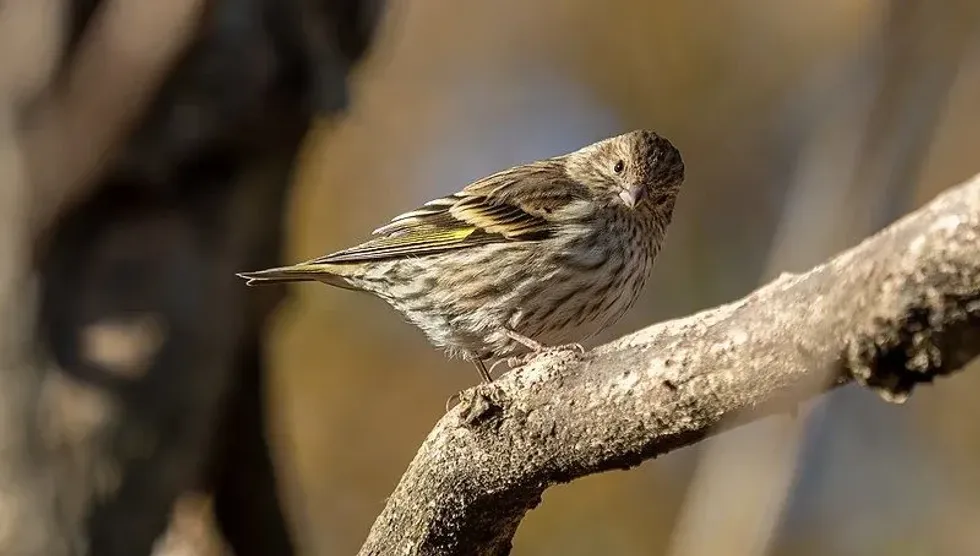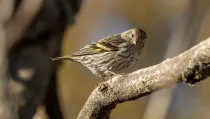The Pine Siskin finch or Spinus pinus is a bird that is native to North America. There are two species of Siskins.
One is found in several parts of Canada, from the lower regions of Canada to central Alaska. The second ones are found in Mexico and the United States, such as the northern areas of the US. They belong to the family of Fringillidae.
They are small songbirds that migrate from the middle to the south of the United States. These streaky birds are very attractive with their plumage being brown.
They have streaks of yellow on their wings and their short tails. They are generally found in mixed or evergreen habitats.
They are not yet termed Endangered or Threatened birds, but with every passing year, their population is declining. However, their population in a given location is variable as they keep migrating. For instance, they might travel to the south in flocks one year and the other year they might not.
This is a property that makes them erratic. The major threats to the lives of these birds are pesticides and some predators such as red squirrels.
Pine siskin vs. goldfinch, Pine Siskin vs. house finch, and Pine Siskin vs. sparrow are some of the very common topics of debate as these are birds that look similar to a Pine Siskin. Pine Siskins are a little smaller than American Goldfinches.
Apart from the size, Goldfinches are brown in color and they can have a few streaks of yellow during the winter, whereas Pine Siskins have a bold streaking on their back and breast which is unmatchable.
Moreover, American goldfinches have conical-shaped bills, whereas Pine Siskins have slender, narrow-shaped bills. The slender, narrow bill of Pine Siskins are unique, and so it helps you identify a Pine Siskin.
Read our interesting facts below so that you can identify a Pine Siskin when you see one. You can also read more articles on pileated woodpeckers and American kestrels.
Pine Siskin Interesting Facts
What type of animal is a Pine Siskin?
A Pine Siskin is a type of bird that belongs to the family of Fringillidae.
What class of animal does a Pine Siskin belong to?
Pine Siskins are birds, and they belong to the class of Aves.
How many Pine Siskins are there in the world?
There is no such calculation or survey done to calculate the total number of Pine Siskins that exist. Still, back in the years 1960-2011, bird banding was used to keep track of all the movements of Pine Siskins, and approximately 675,000 Pine Siskins were banded.
Their population is considered one of the most common among finches, and there are about 40 million Pine Siskins globally.
Where does a Pine Siskin live?
Pine Siskins live in open woodlands or open coniferous forests and are native to North America, but they are now common and widespread across Canada, Mexico, and more.
What is a Pine Siskin's habitat?
Pine Siskins are birds that are generally found in habitats such as open conifers or deciduous trees as there, cone seeds are abundant. They can also nest in cemeteries, parks, and open woodlands. In addition to these, they may forage in diverse habitats such as grasslands, weedy fields, deciduous forests, lawns, roadsides, and backyard gardens.
They generally migrate to conifers for breeding. These birds often visit some feeders in their backyards when they offer seeds.
In winters, they form large flocks and migrate accordingly. Mainly they look for the availability of seeds. For example, when the cone crops are short in the northern parts, these finches move to the western slope of the Cascades in Washington.
Who do Pine Siskins live with?
Pine Siskins are social birds, and so they tend to have a gregarious attitude. They usually migrate and travel in large flocks which are quite noisy. They also join flocks of goldfinches, birds that are closely related to them.
How long does a Pine Siskin live?
Pine Siskins have a decent life expectancy; that is, they live for five to six years in the wild, and there is no such data regarding captivity because they are not kept in captivity.
In the year 1966 in Michigan, a Pine Siskin was found with a life span of eight years eight months and that is considered to be the oldest Pine Siskin discovered.
How do they reproduce?
Pine Siskins are polyandrous finches which means the females have more than one mating partner. They generally have two mating partners. The breeding takes place in early spring, around January and February, and the season lasts until summer ends.
They usually breed once or twice every year. Just before breeding, the male Pine Siskins perform courtship rituals, which include a mating song.
It is the song that attracts the females to mate. Females usually get attracted to males who perform good songs and ones who offer food during copulation. After mating, the males go on foraging for food, and the females build their nests to lay their eggs.
The average clutch size of Pine Siskins is two to five eggs per clutch. Their incubation period usually lasts for around 13 days.
During the incubation period, males go in search of food for their breeding partners. Their young ones weigh around 0.002-0.005 lb. They start flying after 15 days, and after three weeks of hatching, they can forage and feed themselves.
What is their conservation status?
According to the IUCN, International Union for Conservation of Nature, these birds are listed as Least Concern.
Pine Siskin Fun Facts
What do Pine Siskins look like?
The Pine Siskin (Spinus pinus) is a little songbird with a sharp, slender bill that is very different from other finches. A Pine Siskin is a streaky bird that is mainly brown in color with streaks of bright yellow on its branched tails and wings and sharp wingtips.
Like other finches, they have colorful feathers and pointed beaks, which helps them pick seeds from cones. These finches have white breasts striped with brown-colored feathers, and their heads are adorned with brown plumage.
How cute are they?
These finches are cute and social. They are also colorful, and they look really beautiful while flying as they spread their wings.
How do they communicate?
Pine Siskins mainly communicate through three major channels, namely visual, acoustic, and tactile. The male Pine Siskin sings a mating song which attracts the female Pine Siskin to mate.
The Pine Siskin call range includes a 'zweeee' when they sing to the female Pine Siskin and 'zweeeet' while they fly and feed the females. The Pine Siskin male learns to sing during its juvenile stage, and these songs indicate various calls which they use to communicate.
A male siskin has a high-pitched voice with chitters, whereas a female has a low-pitched, coarse voice during their calls. Pine Siskins scan and observe with the help of their vision.
They increase their alertness when they are foraging alone as compared to when they are in flocks. They use tactile cues during a fight.
How big is a Pine Siskin?
They are 4.3-5.5 in (11-14 cm) in length and weigh around 0.4-0.6 oz (12-18 g). They have a wingspan of 7.1-8.7 in. These birds are approximately half the size of hawfinches.
How fast can a Pine Siskin fly?
There is no such appropriate estimation of their flying speed, but they have an undulating speed, especially when they are in flight in flocks.
How much does a Pine Siskin weigh?
An adult Pine Siskin's weight ranges from 0.02-0.03 lb (0.012-0.018 kg). Whereas a juvenile Pine Siskin weighs 0.002-0.005 lb.
What are their male and female names of the species?
In terms of gender, there is no such classification based on their names, and so they are collectively known as Pine Siskins. Scientists refer to them as Spinus pinus.
What would you call a baby Pine Siskin?
A baby Pine Siskin belongs to the class of birds and a baby bird is referred to as a chick. Similarly, a baby Pine Siskin can be referred to as a chick.
What do they eat?
Pine siskins are omnivores, and so their diet consists of insects, spiders, and seeds. Mainly they eat seeds of coniferous trees. These birds are also called granivores as they usually prefer seeds.
They are found in coniferous forests where they feed on spruce, hemlock, pine, and cedar seeds, and they also feed on some seeds from weeds like dandelions, chickweed, and ragweed. They also eat sunflower seeds and so it is used as bait to catch them.
Pine Siskins feed on insects as well. They consume insects and their larvae as a source of their nutrition. They also feed at bird feeders in some urban regions.
Are they aggressive?
Yes, winter flocks are usually aggressive, and even individual birds are aggressive while foraging as they are very competitive.
Would they make a good pet?
No, until now, there is no such information on Pine Siskins being pets, but they are really good backyard feeders, so you can feed them with some thistle, seeds, and nuts in your backyard or lawn.
Did you know...
Pine Siskins have a throat pouch that is specifically designed in Siskins to store food. Their throat pouch can stock up to 10% of the birds' weight. These stocks help them on winter nights where they cannot forage for food, and the stored seeds act as a great source of energy for them.
Pine Siskins are often found hanging upside down to pick and eat the seeds from coniferous trees.
Pine Siskins are nomads, and so they migrate according to the available sources of food, even to colder climates. Hence, they can multiply and increase their metabolic rate by 40% to maintain the stability of their body temperature even during winters.
What is a Pine Siskin nest made of?
The nests of Pine Siskins are made of rootlets, grasses, lichens, bark skin, and twigs. Furthermore, it is rimmed with plumage, rootlets, fur, and other flexible substances to insulate and protect their eggs.
The female builds their nests in five to six days and it is she who gathers all the materials.
They even use clothes, cotton, string, and paper to build their nests in areas away from forests or suburban areas. The inner lining of the nest is done with some soft and delicate object to protect the eggshells from cracking.
What do male Pine Siskins do during mating?
The Pine Siskin bird is one of the very social finches, so they use a Pine Siskin song to attract the females.
The male Pine Siskins sing their mating song during the courtship, and the male siskin whirls around the canopy in circular directions along with singing in their high-pitched voices until the pine siskin female responds. The male feeds the female throughout her incubation period and continues to sing his song to her.
In addition to that, the male continues to feed the females for around eight to nine days after the eggs hatch.
Here at Kidadl, we have carefully created lots of interesting family-friendly animal facts for everyone to discover! Learn more about some other birds, including yellow warbler or shrike.
You can even occupy yourself at home by drawing one on our Pine Siskin coloring pages.










